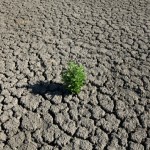She Just Won’t Leave: La Niña, Drought, Will Stay Until Spring
Stop me if you’ve heard this one before: Government forecasters today reported that the drought will not be over before Spring.
La Niña, the dry weather pattern that has been in part responsible for the drought this past year, is going to stick around a little longer, say scientists with the National Oceanic and Atmospheric Administration (NOAA). That means “drier-than-average” conditions throughout the South and Texas.
La Niña is a weather pattern where the surface temperatures are cooler in the Pacific, which creates drier, warmer weather in the southern U.S. (You may also know her counterpart, El Niño, which generally has the opposite effect.) La Niña sticks around for a year, sometimes longer, and tends to return once every few years. The last La Niña occurred in 1995.
But a majority of the NOAA models of La Niña predict that it will dissipate from March to May.
“It’s not all that bad,” John Nielsen-Gammon, the state climatologist, told StateImpact Texas. “First of all, normally La Niña lasts about that time frame. Secondly, as you get into April and May the correlations between our weather and La Nina weaken so it doesn’t have as big of an impact.”
La Niña will be leaving during the typical rainy season in Texas, a time when spring rains could help replenish water sources. But, “the odds are tilted toward slightly dry weather, but not strongly so,” Nielsen-Gammon says. “There’s nothing in the forecast that’s surprising. This is how we expected it to play out.”
Real relief from the drought — the point when reservoirs and lakes return to normal levels — likely won’t come before next winter. “We’d have to be pretty lucky to see reservoir levels rise during the summer because that’s when demand is the greatest,” Nielsen-Gammon says.
But what if La Niña leaves in the Spring, and then returns? That’s what happened last year, and was a major factor in the drought: back-to-back La Niñas. And in five out of the last ten 2-year La Niñas, they were followed by a third year of the pattern. Nielsen-Gammon says there’s “no guarantee” that won’t happen this time, which would take the record single-year drought into even more extreme territory.


